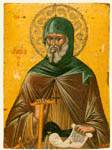|
|
| Portable Icons |
17th c. Dionysiou Monastery Wood, egg tempera, 40.3 x 29.2 x 1.5 cm |
|

|
This is the first of a series of four icons by the same early seventeenth-century painter (see also next text). All the works have features in common, as regards both the technique and the style in which the figures are rendered. The iconographic scheme is such that the saint's figure occupies the entire breadth of the icon at the base. The arms and shoulders form an isosceles triangle that with almost geometrical precision reaches its apex at top centre, thus focusing attention on the saint's face. The flesh is modelled in brown half-tones with a few white brush-strokes for the highlights. The drapery is flat and the folds are rendered with straight lines and angles, creating a remarkably harsh impression and a lack of depth in the saint's body. The style of the wall-paintings in the monastery's later refectory is similar (1603, Millet 1927, pl. 211.1-3) and it is quite possible that this series of four icons was executed by the same painters at the beginning of the seventeenth century when they were doing the wall-paintings for the monastery's chapels (Gabriel D., 1959, pp. 54, 121). The founder of the monastic life (+ 356) is portrayed half-length, holding an open scroll and supporting his right hand on his monastic staff. The strange shape of the rather large cross hanging by a cord at his chest (the upper arm is the same length as the lower) is repeated on his hood. His belt is also rendered in an unusual fashion; it is buckled at the front and its free end is bent over and hangs down behind his staff. This iconographic type of the saint shown half-length is known to have originated in a Palaeologan model, and is repeated with minor variations throughout the sixteenth century (Eikones p. 562). The model for the present icon, however, must be sought in the type of the full-length saint as in the icon by Andreas Pavias (late 15th-early 16th c.), which also has the monastic staff, the cross on chest and hood, and other points in common (Vokotopoulos 1995, p. 157). It is clear that the saint's characteristic gesture, in which he holds an open scroll with both hands in the icon by Michael Damaskinos (Byzantine Museum), has been transferred by the Dionysiou painter to the figure of St John Klimax in the same series (see 2.124). | |
| Bibliography: Eikones Dionysiou. | ||
| I.T. | ||
| Index of exhibits of Monastery of Dionysiou 17th century |
||
Reference address : https://www.elpenor.org/athos/en/e218ab123.asp